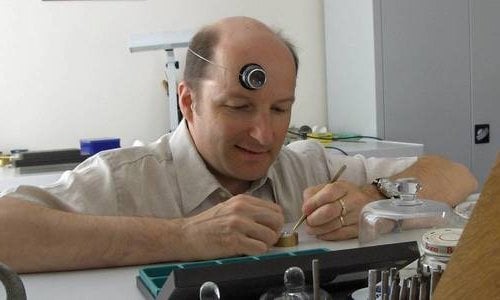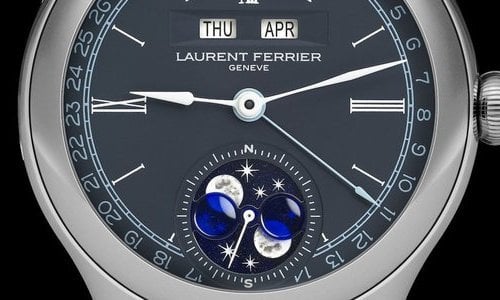It is said that the painter Paul Gauguin liked to declare: “I close my eyes to see”. The watchmakers at A. Lange & Söhne adopted this slogan as their own—and not just figuratively—when they organized the launch of their new watch, the Lange Zeitwerk (literally ‘Work of time’) during a gala dinner, they decided to hold it in absolute darkness.
The fascinating experience took place in Berlin and having attended the event, I can confirm that one doesn’t necessarily close the eyes in the dark. On the contrary, they are kept wide open. In doing so, the other senses become very sharp, to the point that we ‘see’ the others and understand them better than if they were visible.
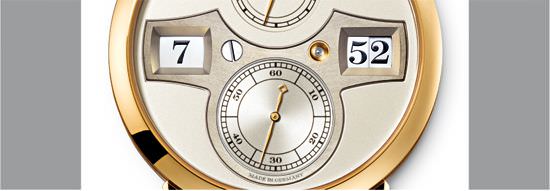
Giving a new face to reading time
I don’t know if the watchmakers at A. Lange & Söhne gathered together in darkened assemblies before they designed this watch but one thing is clear; they sought, above all, to rid themselves of old habits in order to re-create a new way of reading the time.
We say ‘re-create’ and not simply ‘create’ because, in watchmaking as in all other art forms, innovation often passes by roads that were neglected or abandoned in earlier times. In this sense, the mechanical numerical display enjoyed its hour of glory in the 18th century, with the grand format of pocket watches which allowed the use of big numerals. However it was left aside when the reduced format of the wristwatch arrived.
The only numerical indication that survived this era was the date display but, due to the small circle in which the numbers were stamped, it was often barely visible. This was why Rolex invented the small loupe that was integrated into the crystal and that magnified the numbers.
Fifteen years ago, on the occasion of the re-launch of A. Lange & Söhne after the German reunification—the watchmakers in Glasshütte presented the inaugural timepiece of their renaissance, the Lange 1, equipped with the first large date in a wristwatch. This large patented date became the distinctive sign of the company and was very successful, as we all know. From then on, all brands began working on their own system to display the date in a large window.
For the watchmakers at A. Lange & Söhne, the solution to achieving the large date consisted of placing the numbers not on a single circle moving all around the watch but rather on a device that connected a small circle, on which were engraved the units, and a cross, on which were engraved the tens. The two—the circle and the cross—interacted in such a way that large numbers could be used, thus creating unparalleled readability. (In place of 31 numbers engraved on a single circle to display the 31 days, this system only needed nine units on the circle, and three tens and a white space on the cross.)
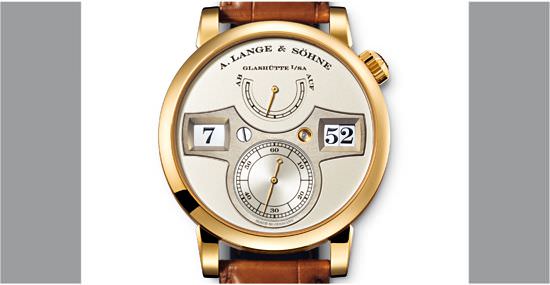
It was thus to be expected that by ‘closing their eyes’, the watchmakers at A. Lange & Söhne began to see a watch whose indication of the time itself was numerical. This was the task they set for themselves with the Lange Zeitwerk.
Now, with our eyes wide open, we discover a watch with a very singular face. A German silver bridge in the shape of a wing encloses the two horizontally aligned date windows. The ‘large hours’ are read at 9 o’clock, and the ‘large minutes’ are read at 3 o’clock. This ‘bridge of time’ flows out over the lower part of the watch and encircles the dial showing the seconds. The upper part of the watch displays the power reserve indicator. The ensemble offers great readability and, thanks to Lange Zeitwerk’s large numbers, reading the time occurs quasi intuitively. It is almost like reading an analogue display whose graphic reading is totally intuitive—in other words, instantaneous—which has made this form of time telling an undeniable success over the centuries.
Yet, the ‘magic’ of this timepiece also operates on a different level, in a rather spectacular fashion, which makes this watch particularly fascinating from a mechanical point of view. The minutes and hours jump to the next one in an instantaneous fashion.
The system used here is not the circle and cross mechanism as in the Lange 1, but rather is composed of three discs: the hour disc that rotates along the plate; the smallest disc that displays the units of the minutes and the disc that shows the tens of the minutes, which is shaped like a rounded hexagon, and is superimposed on the units disc.
To provide the instantaneous and simultaneous jump of the three discs in these large sizes requires a particularly high level of energy. In the Lange Zeitwerk, this energy is obtained from a new barrel equipped with an extra strong spring motor. The rotational torque of this new barrel has been increased thanks to a reversal of the principle of winding and unwinding. As long as the barrel wheel transmits its energy to the movement and then unwinds, it continues to turn in the reduced friction bearing, but when the watch is rewound, it is the intense friction bearing that comes into play. The watch is then a little more difficult to wind, but this device, which drives a strong 3.32-mm spring, allows the available rotational torque to be increased in order to provide both energy to the watch and to the instantaneous jump of the three discs.
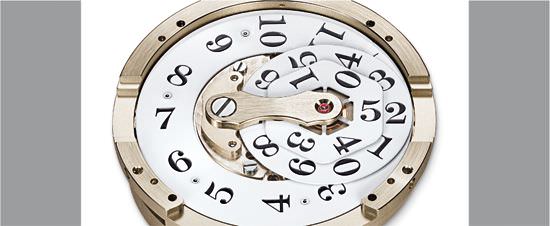
The advances of the jumping hours and minutes are ‘driven’ by a constant force escapement that has also been patented. Its principle originality resides in a regulator with small blades that has been integrated into the mechanism. By dissipating a large part of the energy using air resistance, the blades of this regulator ensure a gentle commutation, thus helping stabilize the operation of the movement whose balance (with off-centred balancing weights and an ‘in-house’ spring) is driven by a nearly uniform force throughout its 36 hours of power reserve.
This manual-winding 3⁄4''' Calibre L043.1 movement has been decorated in the great Saxon traditions. It is fitted into a 41.9-mm case (available in platinum as well as yellow, white, or pink gold), which features a choice of dials in solid silver with a finish in champagne, black, silver or rhodium-plated. The winding crown, located at 2 o’clock, gives the watch’s ultra classic appearance a touch of contemporary dynamism.
To really appreciate this timepiece’s unique dial is to see it in action. The unyielding and perfectly precise jump of the numbers makes the reading of time quite special. We get the feeling that, under its apparent simplicity, an implacable mechanism is at work.—This is the quintessence of the spirit of A. Lange & SÖhne.
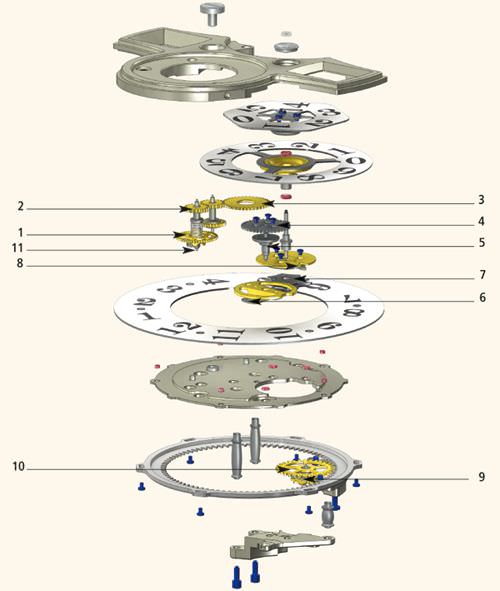
THE LANGE ZEITWERK CONSTANT-FORCE ESCAPEMENT
A constant-force escapement generates the precise minute steps. Every 60 seconds, these steps are transmitted to the disc mechanism as abrupt advances by one-fifth of a revolution (72 degrees) via the driving wheel (1) and—seated on the same arbour—the pinion (2).
This incrementally rotating pinion engages with the wheel (3) that carries the units disc. The same wheel is geared to the wheel (4) that via the switching staff (5) is connected to the tens switching wheel, which carries a finger with a stone (6). Each time the units disc has performed a complete revolution, i.e. every ten minutes, the stone engages with the six-toothed switching star (7) of the tens arbour and advances it by one-sixth of a full revolution (60 degrees) just when the units disc jumps from 9 to 0. This moves the tens disc forward by exactly one numeral.
After it has performed a complete revol-ution, the tens arbour switches the large hours ring (with the numerals 1 to 12) forward by one step. For this purpose, it is fitted with a wheel that has only one tooth (8) that engages with the four-toothed switching star (9) of the intermediate hour wheel (10). When the tens disc advances from 5 to 0, the intermediate hour wheel is switched forward by a one-fourth of a full revolution (90 degrees). In this case, too, a form-fit safety interlock between the tens arbour and the intermediate hour wheel assures that the hours ring cannot advance inadvertently.
Source: Europa Star August-September 2009 Magazine Issue



